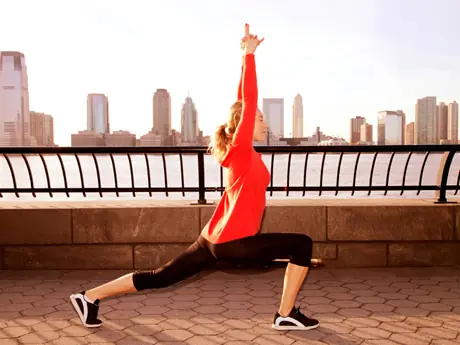
Right before a race, the last thing you want to do is tire yourself out. Your primary objective is conserving energy for the test ahead. It's hard to imagine a better way to sabotage a race than doing a hard workout moments before the race begins.
Starting a race immediately after you roll out of bed wouldn't turn out very well, either. A certain amount of activity is required to prepare the body for intense exertion. Most runners find a happy medium by doing a gentle warm-up that consists of slow jogging and perhaps some stretching. But research has shown that the most effective pre-race warm-up also includes small doses of specific kinds of intense activity. Adding these elements to your warm-up routine will help you perform better in your next event.
There are three distinct ways in which warming up prepares the body to race. The first of these is suggested by the very name of the practice. The muscles function most efficiently when they are warmer than they are at rest. A good warm-up raises the temperature of the muscles so they're ready to work at maximum efficiency when the race starts.
More: 7 Ways to Become a Morning Runner
In 2009, Chinese researchers designed a clever study that separated the warming effect of warming up from its other effects and highlighted its importance. Eight volunteers underwent a test of muscle performance on three occasions. On two occasions, their muscles were passively warmed for 15 minutes beforehand, once with heat packs and once with ultrasound. On the other occasion, the subjects completed the muscle performance test without prior muscle warming. They performed significantly better on the test on the two occasions when their muscles were warmed.
If warming the muscles were the only benefit of warming up, then you could do it passively, the same way the subjects in the Chinese study did. But there are a couple of other benefits of warming up that require activity.
The second benefit of warming up is what we might call metabolic priming. When you start running hard at the beginning of a race, there's a lag period when your breathing rate and the type of fuel in your muscles gradually adjust to the activity level of your muscles. After this period of adjustment, your breathing rate and choice of muscle fuel stabilize at the appropriate levels.
A good warm up eases this transition. As a result, your muscles rely less on inefficient anaerobic metabolism throughout the race. Studies have demonstrated that low-intensity and high-intensity warm-ups are equally effective in this regard.
More: Find Your Race Pace
It's not just the metabolic system that needs to be primed for racing. The neuromuscular system does as well. Optimal running performance depends on efficient two-way communication through nerves that connect the brain and the muscles. A good warm-up opens up these lines of communication and sends an initial message to the brain to prepare for exertion.
Light jogging is not sufficient for neuromuscular priming. Two other methods work much better: mobility exercises and plyometrics. Mobility exercises are a cross between moving stretches and bodyweight-strength movements. The walking lunge is one example. Such actions serve to reduce internal inhibition, or resistance, in the performance of sport-specific movements such as the running stride, making them more efficient.
Plyometrics are jumping exercises. Running itself is a form of jumping, and it becomes more plyometric in nature when it's done at high intensity against some form of resistance, such as a hill. Plyometrics boost subsequent running performance through a mechanism known as post-activation potentiation, which is a fancy way of saying you can jump higher after you've already jumped at least once.
The effectiveness of mobility exercises and plyometrics as warm-up tools has been experimentally proven. In a 2008 study, Indian researchers had 15 volunteers run to exhaustion on a treadmill after completing each of four different warm-ups on separate occasions: light jogging only, light jogging followed by static stretching, light jogging followed by dynamic stretching, and light jogging followed by mobility movements, which started at low intensity and ended at high intensity. On average, the subjects were able to run for 27:41 after the warm-up involving mobility movements, compared to only 18:19, 21:45, and 23:45 in the other three trials.
More recently, scientists at the Sports Performance Research Institute New Zealand compared the effects of warm-ups with and without a plyometric element on running performance. On one occasion, 11 well-trained runners performed a warm-up consisting of 10 minutes of light jogging followed by six 10-second "strides" (relaxed sprints) before completing a test of running economy and a run to exhaustion at incrementally increasing speeds. On a separate occasion, the runners completed the same warm-up while wearing a weight vest equal to 20 percent of their body mass and then performed the same running economy and exhaustion tests.
The results were striking considering how small the difference between the two warm-up protocols. In the trial involving the weight vest, the runners exhibited six percent better running economy and attained a 2.9 percent greater running speed at the point of exhaustion. These improvements were associated with a 20 percent gain in leg "stiffness," which refers to the legs' ability to capture and reuse energy from impact with the ground.
- 1
- of
- 2
About the Author

Get ACTIVE on the Go


Couch to 5K®
The best way to get new runners off the couch and across the finish line of their first 5K.
Available for iOS | Android






Discuss This Article